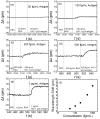Sensitivity Equalization and Dynamic Range Expansion with Multiple Optofluidic Microbubble Resonator Sensors
- PMID: 37887104
- PMCID: PMC10605928
- DOI: 10.3390/bios13100911
Sensitivity Equalization and Dynamic Range Expansion with Multiple Optofluidic Microbubble Resonator Sensors
Abstract
A novel multi-optofluidic microbubble resonator (OMBR) sensitivity equalization method is presented that equalizes the sensing signal from different OMBRs. The method relies on the fact that the ratio of the wavelength shifts to the bulk refractive index sensitivity (BRIS) does not depend on the physical dimensions of the OMBR. The proof of concept is experimentally validated and the sensing signals from individual OMBRs can be directly compared. Furthermore, a wide dynamic range of sensing with favorable consistency and repeatability is achieved by piecing together signals from 20 OMBRs for HIV-1 p24 antigen detection from 50 fg/mL to 100 ng/mL (2.1 fM to 4.2 nM), indicating significant potential for practical applications, such as in drug screening and disease diagnosis.
Keywords: HIV-1 p24; WGM; biosensing; optofluidic.
Conflict of interest statement
The authors declare no conflict of interest.
Figures








References
-
- Vollmer F., Braun D., Libchaber A., Khoshsima M., Teraoka I., Arnold S. Protein detection by optical shift of a resonant microcavity. Appl. Phys. Lett. 2002;80:4057–4059. doi: 10.1063/1.1482797. - DOI
-
- Dong C., He L., Xiao Y., Gaddam V., Özdemir S., Han Z., Guo G., Yang L. Fabrication of high-Q polydimethylsiloxane optical microspheres for thermal sensing. Appl. Phys. Lett. 2009;94:231119. doi: 10.1063/1.3152791. - DOI
MeSH terms
Grants and funding
LinkOut - more resources
Full Text Sources

